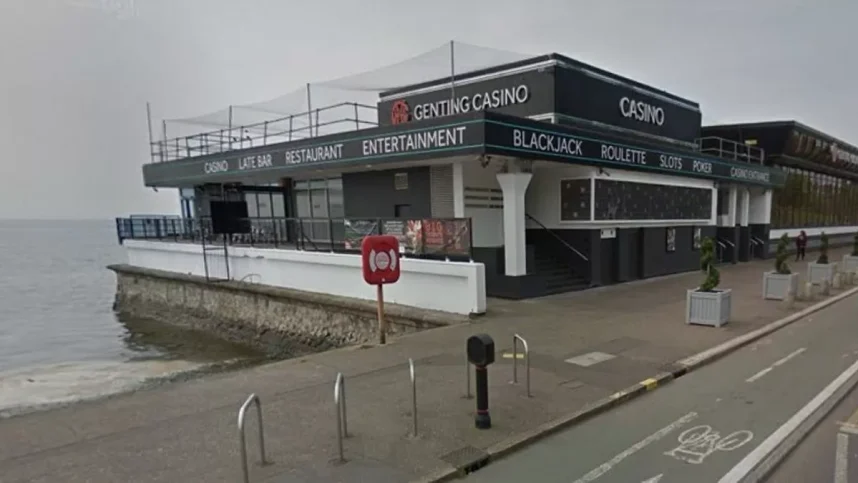Genting Shuts Down UK Casino Over Structural Stability Concerns
Posted on: November 7, 2023, 06:42h.
Last updated on: November 7, 2023, 10:59h.
The Genting Casino in Westcliff on Sea in the UK is out of commission. It abruptly shut its doors after finding reinforced autoclaved aerated concrete (RAAC) had been used in its construction, sparking concerns over the property’s safety and structural integrity.

The UK arm of Resorts World Genting ordered the property to close its doors “with immediate effect” following the discovery. A message on the casino’s website explains that the presence of the concrete was found as the property was undergoing routine maintenance.
The material was found in the casino’s roof, which poses a serious safety risk and raises fears of potentially catastrophic structural issues.
In the statement, Genting confirmed that a thorough inspection is taking place to assess the extent of the problem and determine the safety of the premises. The closure comes as a precautionary measure, and there was no indication that the roof was in imminent danger of collapsing.
The statement didn’t provide a time line for when the casino is expected to reopen. However, it appears that the closure may continue for a while. Genting recommended that Westcliff gamblers find alternative locations, and said that it will continue to provide regular updates on the situation on its social media channels.
Complete Structural Failures
RAAC is a type of concrete that undergoes autoclaving, a process involving high-pressure steam curing, making it lightweight and energy-efficient. However, recent scrutiny has highlighted its potential weaknesses, especially in load-bearing structures.
The UK used RAAC in construction for decades, primarily beginning in the 1950s. Despite structural engineers’ warnings that the concrete would only last about 30 years, nothing was done to take corrective measures.
While not all structures using RAAC experience issues, there have been notable instances where its weaknesses have manifested. One prominent case involves the construction of residential properties in the UK.
Concerns have been raised about the long-term durability of RAAC in these settings, with reports of cracks and structural problems emerging over time. These issues have led to debates about the suitability of RAAC, touted for its lightweight and energy-efficient properties, for load-bearing applications in residential construction.
Additionally, there have been instances of structural problems in buildings with RAAC components, raising questions about the material’s overall reliability. A commercial building in Manchester experienced a partial collapse, with investigations pointing to RAAC as a contributing factor. The incident prompted a reevaluation of the use of RAAC in similar structures.
Most UK Schools at Risk
One of the biggest issues centers on UK schools. RAAC helped the country save money on the construction of the buildings, but is now costing the country more in regard to maintenance and repair. Over 174 schools were built using the material.
In September, just as the fall term was about to get underway, more than 100 schools were immediately closed. It was previously believed that they were safe, but further inspections revealed otherwise.
Now, temporary and virtual classrooms have replaced the structures. A complete inspection is underway, and officials are reportedly replacing the material. But it’s a problem that could take years to resolve.
Related News Articles
Grosvenor Casino Union Employees to Walk Out in Demand for Better Pay
UK Casinos Return to the European Casino Association Following Brexit
Grosvenor Casinos to Rebrand as it Seeks to Become More ‘Fun’
UK Casinos Shut Down as Inflation Takes Toll on Gaming Industry
Most Popular
FTC: Casino Resort Fees Must Be Included in Upfront Hotel Rates
Genovese Capo Sentenced for Illegal Gambling on Long Island
NBA Referees Expose Sports Betting Abuse Following Steve Kerr Meltdown
UPDATE: Former Resorts World & MGM Grand Prez Loses Gaming License
Most Commented
-
UPDATE: Whiskey Pete’s Casino Near Las Vegas Closes
— December 20, 2024 — 30 Comments -
Caesars Virginia in Danville Now Accepting Hotel Room Reservations
— November 27, 2024 — 9 Comments -
UPDATE: Former Resorts World & MGM Grand Prez Loses Gaming License
— December 19, 2024 — 8 Comments -
FTC: Casino Resort Fees Must Be Included in Upfront Hotel Rates
— December 17, 2024 — 7 Comments
















No comments yet